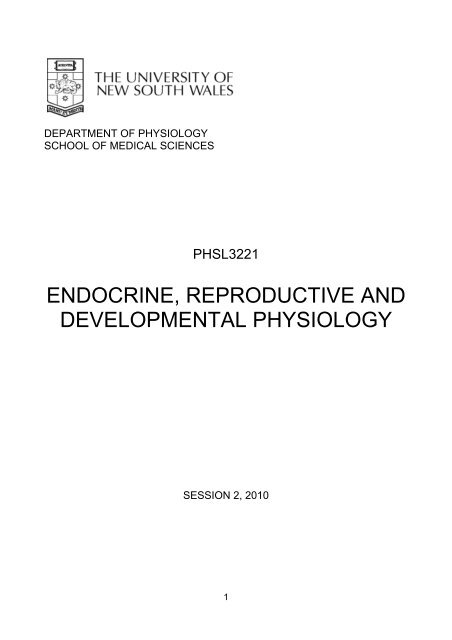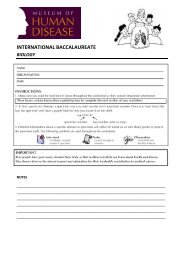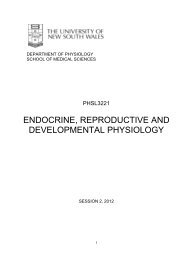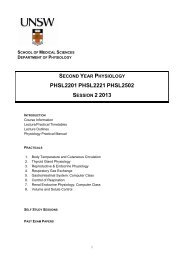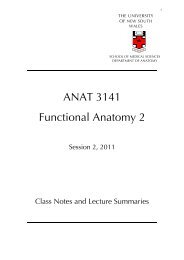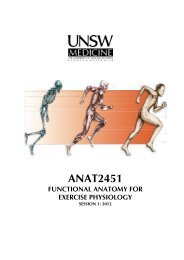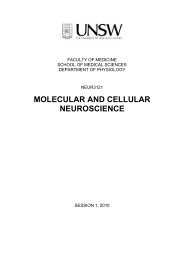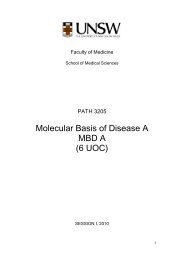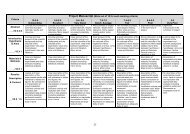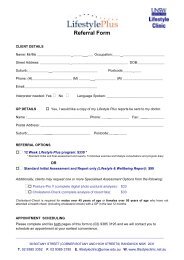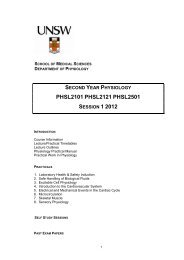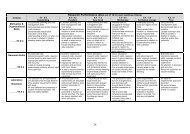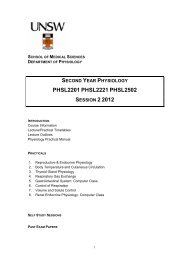endocrine, reproductive and developmental physiology - School of ...
endocrine, reproductive and developmental physiology - School of ...
endocrine, reproductive and developmental physiology - School of ...
You also want an ePaper? Increase the reach of your titles
YUMPU automatically turns print PDFs into web optimized ePapers that Google loves.
DEPARTMENT OF PHYSIOLOGY<br />
SCHOOL OF MEDICAL SCIENCES<br />
PHSL3221<br />
ENDOCRINE, REPRODUCTIVE AND<br />
DEVELOPMENTAL PHYSIOLOGY<br />
SESSION 2, 2010<br />
1
CONTENTS<br />
Page<br />
1. Course staff 3<br />
2. Course information 4<br />
3. Assessment 7<br />
4. Problem based learning<br />
5. Academic honesty <strong>and</strong> plagiarism<br />
8<br />
10<br />
6. Course schedule <strong>and</strong> attendance requirements 11<br />
7. Resources for students 12<br />
8. Continual course improvement 13<br />
9. General Information<br />
10. Past exam questions<br />
11. Timetable<br />
13<br />
16<br />
27<br />
2
1. COURSE STAFF<br />
Course conveners:<br />
• Dr Karen Gibson<br />
Senior Lecturer<br />
Department <strong>of</strong> Physiology, <strong>School</strong> <strong>of</strong> Medical Sciences<br />
Wallace Wurth Building, Room 210C<br />
k.gibson@unsw.edu.au<br />
9385 3650<br />
• Dr Am<strong>and</strong>a Boyce<br />
Lecturer (Part-time: Tues-Fri)<br />
Department <strong>of</strong> Physiology, <strong>School</strong> <strong>of</strong> Medical Sciences<br />
Wallace Wurth Building, Room G1<br />
a.boyce@unsw.edu.au<br />
9385 3684<br />
Other Teaching Staff (Lecturers)*:<br />
Name Department Contact e-mail<br />
Dr Anne Clark<br />
Medical Director, Fertility First Centre for<br />
Reproductive Health<br />
Please arrange contact through<br />
Drs Boyce or Gibson<br />
Dr Bronwyn Hegarty Black Dog Institute<br />
b.hegarty@unsw.edu.au<br />
Hospital Rd, R<strong>and</strong>wick NSW 2031<br />
Pr<strong>of</strong>essor Edward Head, Diabetes Research Group,<br />
e.kraegen@garvan.org.au<br />
(Ted) Kraegen Diabetes & Obesity Research Program,<br />
Garvan Institute <strong>of</strong> Medical Research<br />
Dr Ross Laybutt Head, Islet Biology Group, Diabetes <strong>and</strong><br />
Obesity Research Program, Garvan<br />
Institute <strong>of</strong> Medical Research<br />
r.laybutt@garvan.org.au<br />
Dr Lu Liu SOMS/Pharmacology lu.liu@unsw.edu.au<br />
Dr Kei Lui<br />
Director, Department <strong>of</strong> Newborn Care,<br />
Royal Hospital for Women/Senior<br />
Lecturer, SWCH<br />
Scientia Pr<strong>of</strong>essor<br />
Emeritus Eugenie<br />
Lumbers<br />
Dr Am<strong>and</strong>a Sainsbury-<br />
Salis<br />
Dr Michael Swarbrick<br />
SOMS/Physiology & Pharmacology<br />
Head, Eating Disorder Research Group,<br />
Neuroscience Research Program, Garvan<br />
Institute <strong>of</strong> Medical Research<br />
Diabetes <strong>and</strong> Obesity Research Program,<br />
Garvan Institute <strong>of</strong> Medical Research<br />
Please arrange contact through<br />
Drs Boyce or Gibson<br />
Please arrange contact through<br />
Drs Boyce or Gibson<br />
a.sainsbury-salis@garvan.org.au<br />
m.swarbrick@garvan.org.au<br />
Dr Lesley Ulman SOMS/Physiology l.ulman@unsw.edu.au<br />
Dr Lei Zhang<br />
Eating Disorder Research Group,<br />
Neuroscience Research Program, Garvan<br />
Institute <strong>of</strong> Medical Research<br />
l.zhang@garvan.org.au<br />
* consultation times by arrangement with specific staff member<br />
3
2. COURSE INFORMATION<br />
2a) General Introduction<br />
Endocrine, Reproductive <strong>and</strong> Developmental Physiology is a 3 rd year Science Course / Level III<br />
Physiology course usually undertaken upon successful completion <strong>of</strong> Physiology 1A<br />
(PHSL2101/2121/2501) <strong>and</strong> 1B (PHSL2201/2221/2502). It is worth six units <strong>of</strong> credit (6 UOC). The<br />
course usually forms part <strong>of</strong> a major in Physiology <strong>and</strong>/or Pharmacology in a Bachelor <strong>of</strong> Science or<br />
Bachelor <strong>of</strong> Medical Sciences degree.<br />
This course has been developed with the aim <strong>of</strong> stimulating your interest <strong>and</strong> exp<strong>and</strong>ing your knowledge<br />
in the areas <strong>of</strong> endocrinology, reproduction, fertility <strong>and</strong> fetal development. The <strong>endocrine</strong> <strong>and</strong><br />
<strong>reproductive</strong> <strong>physiology</strong> component builds on areas covered in Physiology 1B. The study <strong>of</strong><br />
<strong>developmental</strong> <strong>physiology</strong> examines a wide range <strong>of</strong> organ systems <strong>and</strong> <strong>endocrine</strong> functions in the fetus,<br />
newborn <strong>and</strong> pregnant woman, <strong>and</strong> in this part <strong>of</strong> the course you will draw on your knowledge <strong>of</strong> these<br />
systems <strong>and</strong> processes from the relevant parts <strong>of</strong> Physiology 1A <strong>and</strong> 1B, <strong>and</strong> also your underst<strong>and</strong>ing <strong>of</strong><br />
basic anatomy <strong>and</strong> biochemistry. The Level III Physiology subject most closely related to this course is<br />
Cardiovascular Physiology <strong>and</strong> Patho<strong>physiology</strong> (PHSL3211).<br />
The learning <strong>and</strong> teaching philosophy that underpins this course is our firm belief that a subject <strong>of</strong>fered in<br />
the final session <strong>of</strong> your degree should not only develop a deeper underst<strong>and</strong>ing <strong>of</strong> <strong>physiology</strong>, but also<br />
foster the development <strong>of</strong> skills useful for your future career. All learning activities in the course are<br />
designed with this in mind.<br />
2b) Aims<br />
This course aims to:<br />
1. develop your underst<strong>and</strong>ing <strong>of</strong> the structure, function, control <strong>and</strong> patho<strong>physiology</strong> <strong>of</strong> <strong>endocrine</strong><br />
systems;<br />
2. develop your underst<strong>and</strong>ing <strong>of</strong> the mechanisms associated with male <strong>and</strong> female reproduction<br />
<strong>and</strong> fertility;<br />
3. provide you with an underst<strong>and</strong>ing <strong>of</strong> normal fetal growth <strong>and</strong> development, post-natal<br />
adaptation <strong>and</strong> survival, <strong>and</strong> maternal <strong>physiology</strong>;<br />
4. develop your skills in teamwork, problem solving, communicating with peers, making<br />
presentations, independent learning, data analysis <strong>and</strong> report writing; <strong>and</strong><br />
5. stimulate an interest in <strong>and</strong> appreciation <strong>of</strong> biomedical research.<br />
4
2c) Science Graduate Attributes, UNSW<br />
UNSW aims to provide an environment that fosters in you the following qualities, skills <strong>and</strong> attributes<br />
during your time here as a Science student:<br />
Science Graduate Attributes, UNSW<br />
1. Research, inquiry <strong>and</strong> analytical thinking abilities.<br />
Technical competence <strong>and</strong> discipline specific knowledge. Ability to construct new concepts or create new<br />
underst<strong>and</strong>ing through the process <strong>of</strong> enquiry, critical analysis, problem solving, research <strong>and</strong> inquiry.<br />
2. Capability <strong>and</strong> motivation for intellectual development.<br />
Capacity for creativity, critical evaluation <strong>and</strong> entrepreneurship. Ability to take responsibility for <strong>and</strong> demonstrate<br />
commitment to their own learning, motivated by curiosity <strong>and</strong> an appreciation <strong>of</strong> the value <strong>of</strong> learning.<br />
3. Ethical, Social <strong>and</strong> Pr<strong>of</strong>essional Underst<strong>and</strong>ing.<br />
Ability to critically reflect upon broad ethical principles <strong>and</strong> codes <strong>of</strong> conduct in order to behave consistently with<br />
a personal respect <strong>and</strong> commitment to ethical practice <strong>and</strong> social responsibility. Underst<strong>and</strong>ing <strong>of</strong> responsibility<br />
to contribute to the community. Respect <strong>and</strong> value social, multicultural, cultural <strong>and</strong> personal diversity.<br />
4. Communication.<br />
Effective <strong>and</strong> appropriate communication in both pr<strong>of</strong>essional (intra <strong>and</strong> inter disciplinary) <strong>and</strong> social (local <strong>and</strong><br />
international) contexts.<br />
5. Teamwork, collaborative <strong>and</strong> management skills.<br />
Ability to recognise opportunities <strong>and</strong> contribute positively to collaborative scientific research, <strong>and</strong> to perceive the<br />
potential value <strong>of</strong> ideas towards practical applications. Demonstrate a capacity for self management, teamwork,<br />
leadership <strong>and</strong> decision making based on open-mindedness, objectivity <strong>and</strong> reasoned analysis in order to<br />
achieve common goals <strong>and</strong> further the learning <strong>of</strong> themselves <strong>and</strong> others.<br />
6. Information literacy.<br />
Ability to make appropriate <strong>and</strong> effective use <strong>of</strong> information <strong>and</strong> information technology relevant to their<br />
discipline.<br />
The generic UNSW Graduate Attributes can also be found at<br />
http://learning<strong>and</strong>teaching.unsw.edu.au/content/LT/course_prog_support/unsw_grad_atts.cfmss=2.<br />
Endocrine, Reproductive <strong>and</strong> Developmental Physiology addresses each <strong>of</strong> these Science Graduate<br />
Attributes. Specific learning outcomes for the course, <strong>and</strong> the manner in which the course addresses the<br />
attributes, are outlined below.<br />
2d) Specific Learning Outcomes<br />
1. On completion <strong>of</strong> this course you should be able to demonstrate your knowledge <strong>and</strong> underst<strong>and</strong>ing<br />
<strong>of</strong> each <strong>of</strong> the three course themes outlined below [this relates to Science Graduate Attribute (SGA) 1].<br />
You should be able to:<br />
1a) better underst<strong>and</strong> the structure, function <strong>and</strong> control <strong>of</strong> <strong>endocrine</strong> systems (weeks 2-7),<br />
including:<br />
- thyroid <strong>physiology</strong> <strong>and</strong> patho<strong>physiology</strong><br />
- insulin <strong>physiology</strong>; type 2 diabetes mellitus<br />
- <strong>endocrine</strong> control <strong>of</strong> body weight; <strong>endocrine</strong> functions <strong>of</strong> white adipose tissue<br />
- biosynthesis <strong>and</strong> actions <strong>of</strong> adrenal corticosteroids<br />
- anabolic steroids<br />
- the <strong>endocrine</strong> <strong>and</strong> renal response to water immersion<br />
- calcium metabolism <strong>and</strong> its hormonal control<br />
- the renin-angiotensin system<br />
5
1b) better underst<strong>and</strong> the science underlying male <strong>and</strong> female reproduction <strong>and</strong> fertility<br />
(weeks 6-8), including:<br />
- changes with puberty, menopause <strong>and</strong> <strong>and</strong>ropause<br />
- hormonal contraception<br />
- fertility <strong>and</strong> assisted <strong>reproductive</strong> techniques<br />
1c) describe the main features <strong>of</strong> fetal growth, development <strong>and</strong> adaptation to life after birth<br />
(Weeks 8-13), including:<br />
- cardiovascular development <strong>and</strong> the unique structural <strong>and</strong> functional aspects <strong>of</strong> the fetal<br />
cardiovascular system<br />
- fetal fluid regulation <strong>and</strong> renal function<br />
- fetal endocrinology<br />
- structure <strong>and</strong> functions <strong>of</strong> the placenta<br />
- lung development <strong>and</strong> fetal breathing movements<br />
- the transition from fetal to neonatal life, lactation <strong>and</strong> early infant nutrition<br />
In addition, after you have completed this course you should be able to:<br />
2. Use your knowledge <strong>of</strong> <strong>developmental</strong> <strong>physiology</strong> to develop an underst<strong>and</strong>ing <strong>of</strong> major areas <strong>of</strong><br />
current interest in <strong>developmental</strong> research [SGAs 1 & 6], including:<br />
- <strong>developmental</strong> origins <strong>of</strong> health <strong>and</strong> adult disease<br />
- imprinting/epigenetics<br />
- the physiological basis <strong>of</strong> neonatal intensive care<br />
3. Demonstrate an ability to contribute effectively in a group to solve a scientific problem. An<br />
effective contribution includes critical enquiry i.e. asking questions to clarify points/prompt<br />
scientific discussion [SGAs 1, 3, 4, 5].<br />
4. Identify areas in your knowledge <strong>of</strong> <strong>physiology</strong> that could be improved, <strong>and</strong> carry out the selfdirected<br />
learning necessary to “fill the gaps” [SGAs 1, 2, 6].<br />
5. Research scientific information <strong>and</strong> communicate it to your colleagues <strong>and</strong> academic staff in<br />
written <strong>and</strong> oral format [SGAs 1, 4, 6].<br />
6. Critically analyse <strong>and</strong> report on experimental data in the light <strong>of</strong> current information within the<br />
literature [SGAs 1, 2, 4, 6].<br />
7. Conduct a focused literature search on a topic related to reproduction <strong>and</strong> <strong>developmental</strong><br />
<strong>physiology</strong> <strong>and</strong> succinctly present this synopsis to your colleagues <strong>and</strong> academic staff [SGAs 1,<br />
2, 4, 6].<br />
8. Demonstrate some familiarity with examples <strong>of</strong> research in areas related to fetal <strong>physiology</strong> <strong>and</strong><br />
development [SGAs 1, 6].<br />
2e) Teaching Strategies<br />
A variety <strong>of</strong> teaching strategies are used in this course:<br />
Lectures introduce aspects <strong>of</strong> core material <strong>and</strong> insights into recent research <strong>and</strong> current practice. The<br />
course conveners both conduct their research in fetal <strong>and</strong> <strong>developmental</strong> <strong>physiology</strong>. We are also<br />
fortunate to have a large number <strong>of</strong> guest lecturers who are expert in their particular area <strong>of</strong> research or<br />
clinical practice. This means that you will gain an insight into both the basics <strong>and</strong> the latest issues<br />
relating to each <strong>of</strong> the course themes [specific learning objectives 1 <strong>and</strong> 2].<br />
The problem based learning tutorials (PBLs) will form a large part <strong>of</strong> your study <strong>of</strong> endocrinology.<br />
These are designed not only to develop your knowledge <strong>of</strong> <strong>endocrine</strong> <strong>physiology</strong> [specific learning<br />
objective 1a], but also to encourage the development <strong>of</strong> self directed learning, teamwork, <strong>and</strong><br />
communication <strong>and</strong> presentation skills [specific learning objectives 3, 4, 5]. More information about PBL<br />
tutorials is given later in these notes.<br />
6
Practical sessions <strong>and</strong> discussion classes are designed to give you a deeper underst<strong>and</strong>ing <strong>of</strong><br />
particular aspects <strong>of</strong> the course. The two ‘Glycaemic Index’ classes investigate the concept <strong>of</strong> glycaemic<br />
index <strong>and</strong> enable you to think critically about the usefulness or otherwise <strong>of</strong> glycaemic index as a tool for<br />
dietary management [learning objective 6]. In these 2 classes you will obtain data from experimental<br />
subjects <strong>and</strong> consider how to analyse the data <strong>and</strong> present it [learning objective 6]. You will consider the<br />
<strong>endocrine</strong> <strong>and</strong> renal control <strong>of</strong> circulating volume in the discussion class on ‘Hormonal effects <strong>of</strong> water<br />
immersion’ [learning objective 1a]. In the practical class on the ‘Placenta <strong>and</strong> Fetal membranes’ you will<br />
examine museum <strong>and</strong> wet specimens <strong>of</strong> placenta <strong>and</strong> membranes at various stages <strong>of</strong> gestation <strong>and</strong><br />
also use virtual microscopy to further your underst<strong>and</strong>ing <strong>of</strong> these important products <strong>of</strong> conception<br />
[learning objective 1c]. During a visit to the neonatal intensive care unit at the Royal Hospital for<br />
Women, R<strong>and</strong>wick you will have a ‘once in a lifetime’ opportunity to see how our underst<strong>and</strong>ing <strong>of</strong> fetal<br />
<strong>and</strong> neonatal <strong>physiology</strong> is applied to treating preterm infants [learning objective 2]. You will also<br />
critically analyse <strong>and</strong> present a research topic related to reproduction, <strong>developmental</strong> or fetal <strong>physiology</strong><br />
in the form <strong>of</strong> a poster presentation [learning objectives 7 & 8].<br />
3. ASSESSMENT<br />
Component<br />
Mark allocation<br />
PBL classes 10%<br />
Endocrinology assignment 10%<br />
Poster presentation 10%<br />
Exam 1 (Endocrine & Reproduction) 35%<br />
Exam 2 (Developmental <strong>physiology</strong>) 35%<br />
Total 100%<br />
Details <strong>of</strong> assessment components <strong>and</strong> their rationale<br />
The assessment components in this course are designed to help you to develop the skills outlined in the<br />
specific learning outcomes, as well as assessing your knowledge.<br />
Problem Based Learning Classes. Your participation in three <strong>of</strong> the four problem based learning (PBL)<br />
classes contributes 10% to your final mark. A description <strong>of</strong> problem based learning <strong>and</strong> its assessment<br />
is included on the following pages.<br />
Endocrinology Assignment. This written report based on a case study in endocrinology will contribute to<br />
10% <strong>of</strong> your final mark <strong>and</strong> should be h<strong>and</strong>ed in to the <strong>School</strong> <strong>of</strong> Medical Sciences Office (MG14,<br />
Ground floor, Wallace Wurth Building) by 5 pm Friday <strong>of</strong> Week 8 (17/9/09). Details about this<br />
assignment will be available on Blackboard. This exercise addresses the specific learning objectives 1b,<br />
4 <strong>and</strong> 5 (above). Please note that late submission <strong>of</strong> this assignment will incur a penalty.<br />
Poster Presentation. In the final week <strong>of</strong> session, you will present a poster providing up to date<br />
information on a topic relating to reproduction, fetal or <strong>developmental</strong> <strong>physiology</strong>, which will constitute<br />
10% <strong>of</strong> your final mark. You will work in small groups to prepare <strong>and</strong> present your posters, <strong>and</strong> you will<br />
be assessed during the session both by your peers <strong>and</strong> by members <strong>of</strong> the academic staff. Each<br />
member <strong>of</strong> the group is expected to participate in the poster presentation, <strong>and</strong> attendance is required for<br />
both poster sessions. Topics <strong>and</strong> further details will be provided later in the session. The poster session<br />
helps to achieve specific learning objectives 1c, 2, 4, 5, 7 <strong>and</strong> 8.<br />
Examinations. Two 90 minute examinations <strong>of</strong> equal weighting are given in this subject. The first will be<br />
held on Tuesday 14th September (Week 8) <strong>and</strong> covers all material relating to the Endocrinology <strong>and</strong><br />
some <strong>of</strong> the Reproductive Physiology components <strong>of</strong> the course, including the Glycaemic Index<br />
practicals <strong>and</strong> the first three PBLs. The second will be held in the <strong>of</strong>ficial examination period <strong>and</strong><br />
assesses only the remaining Reproductive Physiology components <strong>and</strong> all Fetal <strong>and</strong> Developmental<br />
Physiology component. The material which will be covered in the second exam is marked with an<br />
asterisk in the timetable. Note this includes the fourth PBL <strong>and</strong> the Placenta <strong>and</strong> Fetal Membranes<br />
7
practical.. Each <strong>of</strong> these examinations consist <strong>of</strong> multiple choice questions <strong>and</strong> short answer (5 minutes<br />
or 10 minutes) questions <strong>and</strong> are designed to help you achieve specific learning objectives 1, 2 <strong>and</strong> 8.<br />
Online formative assessment<br />
Formative assessment questions are available online (via blackboard). These questions are multiple<br />
choice <strong>and</strong> are <strong>of</strong> a similar nature to those that will be in the summative exams. We strongly recommend<br />
that you use these as a guide when studying for these exams <strong>and</strong> to provide feedback to help you learn.<br />
What other feedback can I get to help my learning <strong>and</strong> to get the most out <strong>of</strong> this course<br />
This is a challenging course <strong>and</strong> the course conveners are more than willing to help make this an<br />
interesting, satisfying way to end your 3 rd year <strong>of</strong> studies. Past exam questions are given at the end <strong>of</strong><br />
this outline, <strong>and</strong> you are encouraged to work through them to provide yourself with feedback on your<br />
progress. We will be holding a practice exam session before the midsession exam, <strong>and</strong> a feedback<br />
session following this exam. You are encouraged to ask questions during lectures, tutorials <strong>and</strong><br />
discussion classes. You will receive ongoing feedback on your PBL participation <strong>and</strong><br />
presentations in the form <strong>of</strong> emailed comments <strong>and</strong> marks, <strong>and</strong> you can also ask your PBL facilitator<br />
for feedback regarding your presentations <strong>and</strong> participation in discussions. If you plan your poster early<br />
you can ask the course conveners for feedback on your design/planned content. If there are any<br />
other ways in which you think that we can give you useful feedback, please let us know.<br />
4. PROBLEM BASED LEARNING<br />
4a) Introduction<br />
Problem based learning provides an opportunity for you, working in a group with others, to determine<br />
what you need to know in order to solve a given problem. A facilitator/tutor is present in the class <strong>and</strong><br />
you are provided with information relating to a clinical problem. The role <strong>of</strong> the facilitator is to maintain<br />
<strong>and</strong>/or provide direction for the group discussion, but not to lead the discussion. Each group will have<br />
approximately 10 students. Guidelines for how individuals within the group should interact will be<br />
discussed <strong>and</strong> determined by group members with guidance from the facilitator.<br />
Throughout the group discussions a scribe lists relevant information extracted from the information<br />
provided, <strong>and</strong> from the group discussion, under the following three headings:<br />
1) Known Information: A summary <strong>of</strong> the important facts related to the case.<br />
2) Hypotheses: Possible hypotheses generated from the summarised information <strong>and</strong> the group<br />
discussion.<br />
3) Learning Objectives: During the group discussion you set Learning Objectives, a list <strong>of</strong><br />
topics/questions, which will require further investigation <strong>and</strong> later reporting to the group. This is the most<br />
important part <strong>of</strong> the exercise. At the end <strong>of</strong> the first session for each PBL case the facilitator divides the<br />
list <strong>of</strong> topics/questions among the group. Each student researches a learning topic <strong>and</strong> the following<br />
week presents the information they have researched to their group.<br />
This entire process aims to help you not only improve your underst<strong>and</strong>ing <strong>of</strong> <strong>endocrine</strong> <strong>and</strong> <strong>reproductive</strong><br />
<strong>physiology</strong> (Specific Learning Objectives 1 <strong>and</strong> 2, above) but also addresses objectives 5, 6 <strong>and</strong> 7.<br />
4b) PBL presentations – how to minimise your group’s workload!<br />
These PBL presentations will probably occupy the majority <strong>of</strong> the time away from class that you allocate<br />
to the first part <strong>of</strong> the course. You must keep in mind that you will come away from each PBL session<br />
with information from at least 10 other students. PBL content is assessed in the exam <strong>and</strong> so you need<br />
to make sure that you are providing each other with effective study materials. A big part <strong>of</strong> what makes<br />
a good presentation in this context (<strong>and</strong> this is included in the marking scheme, below) is conciseness.<br />
Think about how effective your h<strong>and</strong>out will be as a study guide for the rest <strong>of</strong> the group. Once it is<br />
written, read through it <strong>and</strong> take out any unnecessary information. At the first PBL session, discuss with<br />
your group what rules you want to establish for giving presentations. These rules should be revised<br />
after the first round <strong>of</strong> presentations if necessary. Start with the following basics:<br />
8
Basic rules for PBL presentations<br />
A strict five minute time limit (shorter if possible – remember that questions take extra time <strong>and</strong> that you<br />
need to get through ~10 presentations in 90 minutes).<br />
1. Limit each presentation to 4 slides.<br />
2. Limit h<strong>and</strong>outs to a maximum <strong>of</strong> one page <strong>of</strong> text (diagrams can be extra if necessary).<br />
3. A brief reference list is compulsory. Highlight any references you found particularly informative <strong>and</strong><br />
which would be useful for the rest <strong>of</strong> the group to study from.<br />
4c) Assessment Criteria for Problem Based Learning Classes<br />
There are two major components in the assessment <strong>of</strong> the PBL classes:<br />
1) Class interaction. For these sessions to work well, all members <strong>of</strong> the group need to participate in<br />
the discussion to the best <strong>of</strong> their ability. The facilitator will assess individuals on their<br />
participation in the group discussion <strong>of</strong> the topic. This assessment will take into consideration the<br />
contribution <strong>of</strong> the individual to group dynamics e.g. politeness, fairness, respect for the opinions <strong>of</strong><br />
others, genuine interest in the learning process. If you are not used to working in a group <strong>and</strong> find<br />
this process intimidating, remember that making an effective contribution to the group can be<br />
something as simple as taking the initiative to read the information sheet aloud for the rest <strong>of</strong> the<br />
group, or asking somebody to repeat something that you did not underst<strong>and</strong>. This would be<br />
regarded as “voluntarily contributing to the group discussion” (see marking scheme below).<br />
2) Reporting. The second part <strong>of</strong> the assessment involves the reporting back <strong>and</strong> discussion <strong>of</strong> the<br />
Learning Objectives, which were allocated in the previous session. The emphasis <strong>of</strong> the<br />
assessment <strong>of</strong> this component is on how you present the information, <strong>and</strong> your ability to answer<br />
questions on your topic.<br />
Marking scheme:<br />
Class Interaction – Assessed by facilitator during session 1 <strong>of</strong> PBLs 2-4<br />
St<strong>and</strong>ard Mark Required Performance<br />
(out <strong>of</strong> 5)<br />
Very Poor 0-1 - no participation in class discussion<br />
Poor 2 - only participated when directed by facilitator/tutor<br />
Adequate 3 - participated in discussion only when directed by other group members<br />
Good 4 - voluntarily contributed to the group discussion<br />
Very Good 5 - initiated <strong>and</strong> participated in the group discussion<br />
- allowed other members <strong>of</strong> the group to contribute<br />
Reporting – Presentation assessed by facilitator during session 2 <strong>of</strong> PBLs 2-4<br />
St<strong>and</strong>ard Mark Required Performance<br />
(out <strong>of</strong> 10)<br />
Very Poor 0-2 - no research or preparation on allocated topic<br />
Poor 3-4 - topic clearly not researched<br />
- explanation unclear<br />
- no underst<strong>and</strong>ing <strong>of</strong> the specific topic<br />
Adequate 5-7 - topic researched <strong>and</strong> explained clearly<br />
- showed some underst<strong>and</strong>ing <strong>of</strong> the specific topic<br />
Good 8-9 - topic researched thoroughly<br />
- clear <strong>and</strong> concise presentation<br />
- had a clear underst<strong>and</strong>ing <strong>of</strong> the specific topic<br />
Very Good 10 - topic researched thoroughly<br />
- clear <strong>and</strong> concise presentation<br />
- had a clear underst<strong>and</strong>ing <strong>of</strong> the specific topic<br />
- able to relate their topic to the whole assignment<br />
9
4d) Are all four PBLs assessed How will feedback be given<br />
We want you to use the first PBL to become familiar with the process <strong>of</strong> problem based learning <strong>and</strong> to<br />
get to know your group. After this PBL, your tutor will send you your assessment via email along with<br />
feedback regarding your participation <strong>and</strong> presentation. This mark will not contribute to your final<br />
assessment. The remaining 3 PBLs will be formally assessed <strong>and</strong> we encourage you to use the<br />
continuing feedback from your tutor to improve your participation <strong>and</strong> presentation skills.<br />
4e) How is problem based learning assessed in the exam<br />
You are not expected to have an intricate knowledge <strong>of</strong> all <strong>of</strong> the material covered during each PBL class<br />
for the midsession exam. However you should be able to demonstrate a broad underst<strong>and</strong>ing <strong>of</strong> the<br />
learning objectives outlined in each PBL, <strong>and</strong> be able to describe the <strong>physiology</strong> underlying each PBL<br />
case. In keeping with this, assessment <strong>of</strong> problem based learning in the exam will be largely by short<br />
answer questions, allowing you to demonstrate a broad underst<strong>and</strong>ing <strong>of</strong> the area, rather than by MCQs,<br />
which tend to assess specific aspects <strong>of</strong> your knowledge. Examples <strong>of</strong> questions relating to PBL classes<br />
in past exams are given at the end <strong>of</strong> this guide.<br />
5. ACADEMIC HONESTY AND PLAGIARISM<br />
Students should be aware <strong>of</strong> UNSW’s policy on academic <strong>and</strong> student misconduct:<br />
https://my.unsw.edu.au/student/academiclife/assessment/AcademicMisconductStudentMisconduct.html<br />
Plagiarism or failure to acknowledge sources will not be tolerated in submitted work. The<br />
University regards this as academic misconduct <strong>and</strong> imposes severe penalties. Written assignments<br />
may be tested for originality against source documents on the Internet <strong>and</strong> other submitted assignments<br />
using the originality detection s<strong>of</strong>tware Turnitin. Evidence <strong>of</strong> plagiarism in submitted assignments, etc.<br />
will be thoroughly investigated <strong>and</strong> may be penalised by the award <strong>of</strong> a score <strong>of</strong> zero for the assessable<br />
work. Flagrant plagiarism will be directly referred to the Division <strong>of</strong> the Registrar for disciplinary action<br />
under UNSW rules.<br />
Students should be familiar with the following:<br />
What is Plagiarism<br />
Plagiarism is the presentation <strong>of</strong> the thoughts or work <strong>of</strong> another as one’s own.* Examples<br />
include:<br />
• direct duplication <strong>of</strong> the thoughts or work <strong>of</strong> another, including by copying material, ideas or<br />
concepts from a book, article, report or other written document (whether published or<br />
unpublished), composition, artwork, design, drawing, circuitry, computer program or<br />
s<strong>of</strong>tware, web site, Internet, other electronic resource, or another person’s assignment<br />
without appropriate acknowledgement;<br />
• paraphrasing another person’s work with very minor changes keeping the meaning, form<br />
<strong>and</strong>/or progression <strong>of</strong> ideas <strong>of</strong> the original;<br />
• piecing together sections <strong>of</strong> the work <strong>of</strong> others into a new whole;<br />
• presenting an assessment item as independent work when it has been produced in whole or<br />
part in collusion with other people, for example, another student or a tutor; <strong>and</strong><br />
• claiming credit for a proportion a work contributed to a group assessment item that is greater<br />
than that actually contributed.†<br />
For the purposes <strong>of</strong> this policy, submitting an assessment item that has already been submitted<br />
for academic credit elsewhere may be considered plagiarism.<br />
10
Knowingly permitting your work to be copied by another student may also be considered to be<br />
plagiarism.<br />
Note that an assessment item produced in oral, not written, form, or involving live presentation,<br />
may similarly contain plagiarised material.<br />
The inclusion <strong>of</strong> the thoughts or work <strong>of</strong> another with attribution appropriate to the academic<br />
discipline does not amount to plagiarism.<br />
The Learning Centre website is main repository for resources for staff <strong>and</strong> students on<br />
plagiarism <strong>and</strong> academic honesty. These resources can be located via:<br />
www.lc.unsw.edu.au/plagiarism<br />
The Learning Centre also provides substantial educational written materials, workshops, <strong>and</strong><br />
tutorials to aid students, for example, in:<br />
• correct referencing practices;<br />
• paraphrasing, summarising, essay writing, <strong>and</strong> time management;<br />
• appropriate use <strong>of</strong>, <strong>and</strong> attribution for, a range <strong>of</strong> materials including text, images, formulae<br />
<strong>and</strong> concepts.<br />
Individual assistance is available on request from The Learning Centre.<br />
Students are also reminded that careful time management is an important part <strong>of</strong> study <strong>and</strong> one<br />
<strong>of</strong> the identified causes <strong>of</strong> plagiarism is poor time management. Students should allow<br />
sufficient time for research, drafting, <strong>and</strong> the proper referencing <strong>of</strong> sources in preparing all<br />
assessment items.<br />
* Based on that proposed to the University <strong>of</strong> Newcastle by the St James Ethics Centre. Used with kind permission from the University <strong>of</strong><br />
Newcastle<br />
† Adapted with kind permission from the University <strong>of</strong> Melbourne.<br />
6. COURSE SCHEDULE AND ATTENDANCE REQUIREMENTS<br />
The course timetable is attached at the end <strong>of</strong> these notes <strong>and</strong> can also be found on Blackboard. You<br />
are expected to attend all rostered activities for their full duration.<br />
Several attendance requirements warrant special mention:<br />
Problem based learning tutorials. PBLs form a major part <strong>of</strong> your learning for the Endocrinology <strong>and</strong><br />
Reproductive components <strong>of</strong> this course. You are relying on other members <strong>of</strong> your group to attend all<br />
sessions, carry out the necessary research <strong>and</strong> report back to the group, <strong>and</strong> they are relying on you to<br />
do the same. For both <strong>of</strong> these reasons attendance at all PBL sessions is compulsory. Non attendance<br />
for other than documented medical or other serious reasons, or unsatisfactory performance, will result in<br />
an additional assessment exam or in ineligibility to pass the course.<br />
Practical classes ‘Glycaemic Index I’, ‘Glycaemic Index II’ <strong>and</strong> ‘Placenta <strong>and</strong> fetal membranes’:<br />
Attendance is compulsory at these classes. The Glycemic Index classes involve the use <strong>of</strong> human<br />
subjects <strong>and</strong> have been considered <strong>and</strong> approved by the university’s Committee on Experimental<br />
Procedures Involving Human Subjects. Each student must read the details <strong>of</strong> this experiment carefully<br />
before embarking on it, <strong>and</strong> is required to raise any matters <strong>of</strong> concern with the person in charge <strong>of</strong> the<br />
class before the experiment has begun. You are expected to behave in a pr<strong>of</strong>essional manner in this<br />
class <strong>and</strong> demonstrate respect for your colleagues during any experiment involving human subjects.<br />
11
Students volunteering to act as subjects will be required to sign witnessed informed consent forms.<br />
These will be distributed <strong>and</strong> collected in the practical class.<br />
The neonatal intensive care visit. Some students will have the opportunity to visit the Newborn Care<br />
Centre at the Royal Hospital for Women, R<strong>and</strong>wick, in practical sessions in weeks 10-12. Students will<br />
sign up to attend these classes on Blackboard. Unfortunately the hospital cannot accommodate all<br />
students. Students who are able to attend must appreciate that this is a tremendous privilege, <strong>and</strong> that<br />
there may be family members there for whom this is a very stressful time. Please dress appropriately,<br />
behave in a pr<strong>of</strong>essional, respectful manner at all times, <strong>and</strong> follow any instructions given to you by<br />
hospital staff. It is essential that you wear closed in shoes or you will not be permitted into Newborn Care<br />
Unit. These staff are spending considerable time <strong>and</strong> effort to <strong>of</strong>fer you this opportunity <strong>and</strong> if you<br />
volunteer to attend this class your attendance is compulsory.<br />
Two peas in a pod. Held concurrently with the neonatal intensive care visits. Your attendance <strong>and</strong><br />
participation is essential.<br />
7. RESOURCES FOR STUDENTS<br />
7a) Textbooks<br />
There are no prescribed texts for this course. Ganong’s ‘Review <strong>of</strong> Medical Physiology’ provides a very<br />
good coverage for the <strong>endocrine</strong> component <strong>of</strong> the course, while Harding & Bocking ‘Fetal Growth <strong>and</strong><br />
Development’ is an excellent reference for <strong>developmental</strong> <strong>physiology</strong>. The others are more specialist<br />
textbooks which are held in the UNSW library <strong>and</strong> could be consulted as a reference if necessary.<br />
NOTE: Ganong’s ‘Review <strong>of</strong> Medical Physiology’ is available as an online text through the UNSW library<br />
catalogue. Copies <strong>of</strong> all other texts have been placed in the MyCourse (Reserve) collection <strong>of</strong> the<br />
UNSW library.<br />
- Ganong,WF. Review <strong>of</strong> Medical Physiology. 23 nd edition, 2010. Lange.<br />
- Harding, R <strong>and</strong> Bocking, AD (eds). Fetal Growth <strong>and</strong> Development. Cambridge UP.<br />
- Laycock, J & Wise, P. Essential Endocrinology. Oxford UP.<br />
- Griffin, JE & Ojeda, SR (eds). Textbook <strong>of</strong> Endocrine Physiology. Oxford UP.<br />
- Thorburn, G & Harding, R. Textbook <strong>of</strong> Fetal Physiology. Oxford UP.<br />
- Nathanielsz, PW. Life Before Birth <strong>and</strong> a Time to be Born. Promethean Press.<br />
7b) Other Resources<br />
- The learning activities may involve supplementary reference articles <strong>and</strong> printed lecture notes.<br />
- For the PBLs you may find Harrison’s online (a medical database, the online version <strong>of</strong> Harrison’s<br />
Principles <strong>of</strong> Internal Medicine) <strong>and</strong> the Oxford Textbook <strong>of</strong> Medicine (electronic resource) useful<br />
resources. These can be accessed via the UNSW library catalogue.<br />
- McPhee, SJ, Vishwanath, RL, Ganong, WF. Patho<strong>physiology</strong> <strong>of</strong> Disease: an Introduction to Clinical<br />
Medicine. 4 th Edition. In MyCourse (Reserve), UNSW library. This is likely to be helpful for the PBLs<br />
<strong>and</strong> the Endocrinology Assignment.<br />
- Blackboard: Lecture notes, course-related material such as timetables <strong>and</strong> outlines, as well as<br />
supplementary articles may be placed on Blackboard. Marks for assessment tasks will also be<br />
posted here. Announcements will be made via Blackboard <strong>and</strong> it is your responsibility to regularly<br />
check this site.<br />
12
8. CONTINUAL COURSE IMPROVEMENT<br />
8a) CATEI<br />
We are continually making changes to this course to keep it current <strong>and</strong> to make it a worthwhile<br />
experience for you. Each year we seek evaluative feedback from students using UNSW's Course <strong>and</strong><br />
Teaching Evaluation <strong>and</strong> Improvement (CATEI) Process. Your feedback is taken seriously, <strong>and</strong> the<br />
improvements we make to the course are based in part on such feedback. In recent years many<br />
students made the comment that although they very much enjoyed <strong>and</strong> valued the PBL classes, they felt<br />
that the workload involved was too large compared with what was expected from other courses. We<br />
reduced the number <strong>of</strong> PBL classes from 5 to 4, partly in light <strong>of</strong> this feedback. Students in 2008 asked<br />
for more feedback to help their learning. In response, in 2009 we provided feedback to each student via<br />
email following each PBL class, <strong>and</strong> produced two formative assessment tools. We will continue this<br />
feedback in 2010. For 2010, we have added a new practical class (Placenta <strong>and</strong> fetal membranes), two<br />
case-based discussion classes (Cross-dressing or crossing over <strong>and</strong> Two peas in a pod) <strong>and</strong> an end<br />
<strong>of</strong> course revision class (Fetal <strong>physiology</strong> Q&A).<br />
8b) Student panel<br />
While we welcome individual students providing us with feedback, your views regarding the course can<br />
also be put forward to the course convenors by a small panel <strong>of</strong> student representatives. These<br />
representatives will have the opportunity to meet with the course convenors during session to provide<br />
feedback on the course structure, learning activities <strong>and</strong> staff. We hope that this will be a useful avenue<br />
for you to make your views known while the course is running.<br />
9. GENERAL INFORMATION<br />
The Department <strong>of</strong> Physiology in the <strong>School</strong> <strong>of</strong> Medical Sciences is located primarily on the 2 nd <strong>and</strong> 3 rd<br />
floors <strong>of</strong> the Wallace Wurth building <strong>and</strong> is within the <strong>School</strong> <strong>of</strong> Medical Sciences, Faculty <strong>of</strong> Medicine.<br />
General inquiries can be made at the <strong>School</strong> <strong>of</strong> Medial Sciences Reception, located at MG14 on the<br />
ground floor <strong>of</strong> the Wallace Wurth building (<strong>of</strong>fice hours are 8:30am - 5:00pm).<br />
Pr<strong>of</strong>essor Gary Housley is Head <strong>of</strong> Department <strong>and</strong> appointments may be made directly with him<br />
(g.housley@unsw.edu.au or phone 9385 1057).<br />
The SOMS Student Advisor, Ms Carmen Robinson (Carmen.Robinson@unsw.edu.au, ph: 9385 2464,<br />
G27 Biosceinces Building), is able to provide additional information on any courses <strong>of</strong>fered by the<br />
<strong>School</strong>.<br />
SCHOOL OF MEDICAL SCIENCES HONOURS PROGRAM<br />
There is an Honours program conducted by the <strong>School</strong>. This program is coordinated by Dr Patsie Polly<br />
(patsie.polly@unsw.edu.au, Room 508 WW, ph: 9385 2924). Any students considering an Honours year<br />
should discuss the requirements with Dr Polly. Outst<strong>and</strong>ing students may be considered for<br />
scholarships <strong>of</strong>fered annually by the University <strong>and</strong> <strong>School</strong>.<br />
POSTGRADUATE RESEARCH DEGREES<br />
The Department <strong>of</strong>fers students the opportunity to enter into the following graduate programs:<br />
Doctorate (PhD): For further information contact the coordinator, Dr Pascal Carrive<br />
(p.carrive@unsw.edu.au).<br />
VACATION SCHOLARSHIPS<br />
13
The <strong>School</strong> <strong>of</strong> Medical Sciences several vacation scholarships each year to enable good students to<br />
undertake short research projects within the Department. For further details contact the Student Advisor,<br />
Carmen Robinson.<br />
BEHAVIOUR IN PRACTICAL CLASSES<br />
Students must take due care with biological <strong>and</strong> hazardous material <strong>and</strong> make sure all equipment is left<br />
clean <strong>and</strong> functional. Covered shoes are compulsory in all practical classes. Please note that<br />
photography <strong>of</strong> experiments involving either animal or human subjects is not permitted under UNSW<br />
Ethics committee guidelines.<br />
CONSENT FORMS<br />
Practical classes involving your participation as a subject require you to sign a witnessed, informed<br />
consent form.<br />
OFFICIAL COMMUNICATION BY EMAIL<br />
Students are advised that email is now the <strong>of</strong>ficial means by which the <strong>School</strong> <strong>of</strong> Medical Sciences at<br />
UNSW will communicate with you. All email messages will be sent to your <strong>of</strong>ficial UNSW email address<br />
(e.g., z1234567@student.unsw.edu.au). If you do not wish to use the University email system, you<br />
MUST arrange for your <strong>of</strong>ficial email to be forwarded to your chosen address. The University<br />
recommends that you check your email at least every other day. Facilities for checking email are<br />
available in the <strong>School</strong> <strong>of</strong> Medical Sciences <strong>and</strong> in the University Library. Further information <strong>and</strong><br />
assistance is available from UNSW IT Services, 9385 1333. Free email courses are run by the UNSW<br />
Library.<br />
UNSW Blackboard<br />
To access UNSW Blackboard go to:<br />
http://telt.unsw.edu.au/<br />
Click on Login to UNSW Blackboard then log on using your zPass Username <strong>and</strong> Password.<br />
zStudentNo <strong>and</strong> password) <strong>and</strong> select the course PHSL3221. You should have access to it if you are<br />
properly enrolled.<br />
System Requirement for BBL:<br />
UNSW Blackboard supports the following web browsers for Windows XP or VISTA.<br />
• Internet Explorer (IE) version 7 or 9<br />
• Firefox 3.0x (must run version 3.0.3 <strong>and</strong> above)<br />
UNSW Blackboard supports the following web browsers for Mac 10.4 or 10.5 (Mac OS 10.3 is not<br />
supported)<br />
• Firefox 3.0.x(must run version 3.0.3 <strong>and</strong> above)<br />
• Safari 2 or 3<br />
Firefox is the preferred browser in both PC & Mac environment.<br />
HANDWRITING<br />
Students whose writing is difficult to underst<strong>and</strong> will disadvantage themselves in their written<br />
assessment. Make every effort to write clearly <strong>and</strong> legibly. Do not use your own abbreviations.<br />
APPLICATIONS FOR SPECIAL CONSIDERATION<br />
Students who miss an assessment through sickness or misadventure, or believe that their performance<br />
has been adversely affected by sickness, misadventure or other circumstances beyond their control<br />
must submit an application for consideration within three working days to UNSW Student Central. Full<br />
details for the application (e.g., Medical Certificate, etc.) are available at<br />
https://my.unsw.edu.au/student/atoz/SpecialConsideration.html<br />
You should also contact the course convenors to inform them that you have applied for special<br />
consideration.<br />
14
MISSED EXAMS<br />
If in any circumstances you unavoidably miss an examination, you must inform the Registrar <strong>and</strong> also<br />
contact the relevant Course Office immediately. Normally, if you miss an exam (without medical reasons)<br />
you will be given an absent fail. If you arrive late for an exam no time extension will be granted. It is your<br />
responsibility to check timetables <strong>and</strong> ensure that you arrive with sufficient time.<br />
DEFERRED EXAMS<br />
If you miss an exam for medical reasons you must supply adequate documentation (including a medical<br />
certificate) to UNSW Student Central within 3 working days <strong>of</strong> the date <strong>of</strong> the exam. Your request for<br />
consideration will then be assessed <strong>and</strong> a deferred exam may be granted. You cannot assume you will<br />
be granted supplementary assessment. It is intended that supplementary exams for the <strong>School</strong> <strong>of</strong><br />
Medical Sciences in Semester 2, 2010 will be held in the week commencing Monday 7 th December,<br />
2010.<br />
MEDICAL CERTIFICATES<br />
Students who miss classes due to illness or for other reasons must submit a copy <strong>of</strong> medical certificates<br />
or other acceptable documentation to Dr Boyce or Dr Gibson. Certificates should be lodged no more<br />
than 7 days after an absence. Certificates lodged after 7 days will not be accepted. The following<br />
details must be attached:<br />
Name, Student number, Course number, Date <strong>of</strong> the class, Name <strong>of</strong> class/es missed.<br />
STUDENT RIGHTS AND RESPONSIBILITIES<br />
Refer to http://www.policy.unsw.edu.au/policy/studegrv.htm<br />
STUDENT SUPPORT SERVICES<br />
Those students who have a disability that requires some adjustment in their teaching or learning<br />
environment are encouraged to discuss their study needs with the course conveners prior to, or at the<br />
commencement <strong>of</strong>, their course, or with the Equity Officer (Disability) in the Equity <strong>and</strong> Diversity Unit<br />
(9385 4734 or http://www.studentequity.unsw.edu.au/content/default.cfmss=0). Issues to be discussed<br />
may include access to materials, signers or note-takers, the provision <strong>of</strong> services <strong>and</strong> additional exam<br />
<strong>and</strong> assessment arrangements. Early notification is essential to enable any necessary adjustments to<br />
be made.<br />
APPEAL PROCEDURES<br />
Refer to<br />
https://my.unsw.edu.au/student/academiclife/assessment/academicst<strong>and</strong>inghowtoappeal.html<br />
GRIEVANCE OFFICER<br />
In case you have any problems or grievance about the course, you should try to resolve it with the<br />
Course Conveners. If the grievance cannot be resolved in this way, you should contact the Head <strong>of</strong><br />
Department, Pr<strong>of</strong> Gary Housley, or the <strong>School</strong>’s Grievance Officer, Dr Priti P<strong>and</strong>ey<br />
(p.p<strong>and</strong>ey@unsw.edu.au, 9385 2483).<br />
15
10. PAST EXAMINATION QUESTIONS<br />
MIDSESSION EXAMINATION, OCTOBER, 2005<br />
1) 20 multiple choice questions (a mixture <strong>of</strong> A-E <strong>and</strong> K-code) in 40 minutes.<br />
2) 8 short answer questions in 50 minutes:<br />
Question 1. (5 minutes)<br />
A close female friend who is on the Combined Oral Contraceptive Pill (The Pill) confides that she missed<br />
taking the last hormonal tablet prior to the week <strong>of</strong> “sugar” tablets. She says she is not worried about<br />
becoming pregnant because her “period” came as usual 3 days later while taking the sugar tablets. You,<br />
however, are worried on her behalf. Explain the physiological reason for your concern.<br />
Question 2. (5 minutes)<br />
a) What are the normal changes in male sexual function with ageing<br />
b) How could you differentiate between erectile dysfunction arising from a psychological cause from that<br />
due to an organic (physical) disorder<br />
Question 3. (5 minutes)<br />
The following test results were taken from an 8 year old child with a history <strong>of</strong> precocious sexual<br />
development:<br />
Patient level<br />
Normal level<br />
Plasma:<br />
11-deoxycortisol 10-30 μg/100 mL
Question 8. (10 minutes)<br />
A 15 year old boy has been brought unconscious into the emergency department by his worried parents.<br />
They say that he has always been in good health, but has been feeling unwell for the past day or so. He<br />
has also been very thirsty <strong>and</strong> has been drinking “lots <strong>of</strong> water”. Blood tests, renal function tests <strong>and</strong> a<br />
physical examination are carried out.<br />
Provide a very brief explanation for each <strong>of</strong> the results below, using only the space provided. The table<br />
continues over the page.<br />
Blood<br />
glucose<br />
concentration<br />
Patient result Normal result<br />
70 mmol/L
Question 7. (5 minutes).<br />
Write brief notes on how the following affect fetal breathing movements:<br />
(i) A reduction in fetal arterial oxygen tension (PO 2 ).<br />
(ii) An increase in fetal carbon dioxide tension (PCO 2 ).<br />
(iii) Fetal asphyxia (reduced PO 2 <strong>and</strong> increased PCO 2 ).<br />
Question 8. (5 minutes).<br />
Briefly describe the effects <strong>of</strong> a low protein diet in pregnant rats on the renin-angiotensin system <strong>and</strong><br />
kidneys <strong>of</strong> the <strong>of</strong>fspring. Include in your answer an explanation <strong>of</strong> why the renin-angiotensin system is<br />
thought to be important for renal development.<br />
Question 9. (5 minutes).<br />
Describe the cycle <strong>of</strong> events that is likely to result in fetal death when there is a sustained fall in fetal<br />
oxygen availability <strong>of</strong> more than 50%.<br />
MID SESSION EXAMINATION, SEPTEMBER, 2006<br />
1) 25 multiple choice questions (a mixture <strong>of</strong> A to E <strong>and</strong> K-code) in 50 minutes.<br />
2) 6 short answer questions in 40 minutes:<br />
Question 1. (5 minutes).<br />
Describe the renal effects <strong>of</strong> head-out water immersion. What are the hormonal mechanisms underlying<br />
these effects<br />
Question 2. (5 minutes).<br />
For each <strong>of</strong> the 4 gut hormones: gastrin, cholecystokinin (CCK), secretin <strong>and</strong> gastric inhibitory peptide<br />
(GIP), briefly describe: (a) its site <strong>of</strong> production, (b) its stimulus for release, <strong>and</strong> (c) its major action.<br />
Question 3. (5 minutes)<br />
Harry <strong>and</strong> his partner Sue are both 40 years old <strong>and</strong> have been trying unsuccessfully to conceive for 18<br />
months. Briefly describe the factors which might be contributing to their infertility.<br />
Question 4 (5 minutes).<br />
Compare <strong>and</strong> contrast menopause <strong>and</strong> “<strong>and</strong>ropause”.<br />
Question 5 (10 minutes).<br />
The following test results were taken from an 8 year old child with a history <strong>of</strong> precocious sexual<br />
development:<br />
Patient level<br />
Normal level<br />
Plasma:<br />
11-deoxycortisol 10-30 μg/100 mL
Question 6 (10 minutes).<br />
A 20 year old woman has been brought unconscious into the emergency department by her worried<br />
boyfriend. He says that she has always been in good health, but has been feeling unwell for the past<br />
day or so. She has also been very thirsty <strong>and</strong> has been drinking “lots <strong>of</strong> water”. Blood tests, renal<br />
function tests <strong>and</strong> a physical examination are carried out.<br />
Provide a very brief explanation for each <strong>of</strong> the results below, using only the space provided. The table<br />
continues over the page.<br />
Patient result Normal result<br />
Brief explanation<br />
Blood<br />
glucose<br />
concentration<br />
70 mmol/L
Question 7. (5 minutes)<br />
What are fetal breathing movements Briefly describe the major factors that control them.<br />
Question 8. (5 minutes)<br />
What do you underst<strong>and</strong> by the term “fetal programming” Include an example in your answer.<br />
MID SESSION EXAMINATION, SEPTEMBER, 2007<br />
1) 25 multiple choice questions (a mixture <strong>of</strong> A to E <strong>and</strong> K-code) in 50 minutes.<br />
2) 6 short answer questions in 40 minutes:<br />
Question 1. (5 minutes)<br />
An overweight friend has been following a sensible low fat low calorie diet for 3 months. In the first 2<br />
months on the diet, he lost weight every week. Now, however, his weight loss has slowed down to<br />
almost nothing, despite the fact that he continues to follow the diet. He still needs to lose more weight.<br />
Your friend wonders why he has stopped losing weight. How would you explain this phenomenon to him<br />
(in lay terms)<br />
Question 2. (5 minutes)<br />
Describe the hormonal changes which occur in the hypothalamic-pituitary-gonadal axis at the onset <strong>of</strong><br />
puberty. What factors influence the timing <strong>of</strong> puberty<br />
Question 3. (5 minutes)<br />
Harry <strong>and</strong> his partner Sue are both 40 years old <strong>and</strong> have been trying unsuccessfully to conceive for 18<br />
months. Briefly describe the factors which might be contributing to their infertility.<br />
Question 4. (5 minutes)<br />
Physical examination <strong>and</strong> blood <strong>and</strong> urine tests taken from a 6 year old child with a history <strong>of</strong> precocious<br />
sexual development revealed the following:<br />
Patient level Normal level<br />
Physical examination<br />
Height 130 cm 95th percentile = 125 cm<br />
Weight 33 kg 95th percentile = 27 kg<br />
Blood pressure 150/90 ~ 100/70<br />
Plasma<br />
11-deoxycortisol 10-30 μg/100 mL
A 20 year old science student has been brought unconscious into the emergency department late at<br />
night by her worried parents. They say that she has always been in good health, but has been feeling<br />
unwell for the past few days. They had wanted her to go to her local doctor yesterday but she had said<br />
that she was too busy studying for exams. She has also been very thirsty <strong>and</strong> has been drinking “lots <strong>of</strong><br />
water”. Blood tests, renal function tests <strong>and</strong> a physical examination are carried out.<br />
Provide a very brief explanation for each <strong>of</strong> the results below, using only the space provided. The table<br />
continues over the page.<br />
Blood<br />
glucose<br />
concentration<br />
Patient result Normal result<br />
70 mmol/L
Question 6. (5 minutes)<br />
Why does the newborn, especially the premature newborn, have difficulty maintaining its body<br />
temperature<br />
MID SESSION EXAMINATION, SEPTEMBER, 2008<br />
1) 20 multiple choice questions (a mixture <strong>of</strong> A to E <strong>and</strong> K-code) in 40 minutes.<br />
2) 8 short answer questions in 40 minutes:<br />
Question 1. (10 minutes).<br />
Peter is an 18 year old gym member who has been injecting himself with Sustanon (testosterone esters)<br />
<strong>and</strong> tamoxifen (a selective estrogen receptor modulator), weekly for the past 6 months. He visits his GP<br />
with concerns that he is developing tender swellings on his chest, either side around the area <strong>of</strong> his<br />
nipples (gynaecomastia). On examination it is found that his testes are s<strong>of</strong>t <strong>and</strong> small.<br />
a) Describe the physiological effects <strong>of</strong> anabolic steroids which entice people like Peter to self<br />
administer these drugs.<br />
b) What is the rationale for taking tamoxifen in conjunction with Sustanon<br />
c) Why has Peter developed gynaceomastia<br />
d) What is the likely explanation for the findings regarding his testes<br />
Question 2. (10 minutes).<br />
A 20 year old science student has been brought unconscious into the emergency department late at<br />
night by her worried parents. They say that she has always been in good health, but has been feeling<br />
unwell for the past few days. They had wanted her to go to her local doctor yesterday but she had said<br />
that she was too busy studying for exams. She has also been very thirsty <strong>and</strong> has been drinking “lots <strong>of</strong><br />
water”. Blood tests, renal function tests <strong>and</strong> a physical examination are carried out.<br />
Provide a very brief explanation for each <strong>of</strong> the results below, using only the space provided. The table<br />
continues over the page.<br />
Patient result Normal result<br />
Brief explanation<br />
Blood<br />
glucose<br />
concentration<br />
70 mmol/L
the time, <strong>and</strong> now her hair is starting to fall out. She has also been constipated despite the fact that she<br />
eats a healthy high-fiber diet <strong>and</strong> drinks plenty <strong>of</strong> water.<br />
On examination she has a s<strong>of</strong>t swelling in her neck which moves on swallowing.<br />
Blood test results were:<br />
T4 2 µg/100 ml (normal 4 – 11 µg/100 ml)<br />
TSH >10 mU/L (normal 0.5-5.0 mU/L)<br />
Explain the <strong>physiology</strong> behind Belinda’s symptoms, signs <strong>and</strong> blood results.<br />
Question 5 (5 minutes).<br />
Rebecca <strong>and</strong> her partner Brett have been trying unsuccessfully to conceive for the past 18 months, since<br />
Rebecca ceased taking the oral contraceptive pill.<br />
a) How could you assess whether Rebecca was ovulating<br />
b) Brett provided a semen sample for analysis. What would you consider to be a normal result<br />
Question 6 (5 minutes).<br />
Matthew is 8 years old <strong>and</strong> is the shortest child in his class at school. He is concerned that he will always<br />
be short. Describe the factors which determine final adult height.<br />
Question 7 (5 minutes)<br />
Explain what is meant by the terms ‘glycaemic index’ <strong>and</strong> ‘glycaemic load’ <strong>and</strong> how these values are<br />
determined.<br />
Question 8 (5 minutes)<br />
A 52 year old woman who is otherwise healthy, presents to her GP suffering from hot flushes, night<br />
sweats <strong>and</strong> insomnia.<br />
a) What changes occur in the hypothalamic-pituitary-ovarian axis as women age<br />
b) What other signs <strong>and</strong> symptoms are likely to occur around menopause <strong>and</strong> why<br />
FINAL EXAMINATION, NOVEMBER, 2008<br />
1) 20 multiple choice questions (a mixture <strong>of</strong> A to E <strong>and</strong> K-code) in 40 minutes.<br />
2) 8 short answer questions in 50 minutes:<br />
Question 1. (10 minutes)<br />
Use your knowledge <strong>of</strong> maternal <strong>physiology</strong> to explain the mechanisms underlying each <strong>of</strong> the following<br />
conditions which are commonly experienced by pregnant women:<br />
(a) ankle swelling<br />
(b) supine hypotension<br />
(c) anaemia<br />
(d) warm h<strong>and</strong>s <strong>and</strong> feet even when the weather is cold<br />
(e) glycosuria.<br />
Question 2. (10 minutes)<br />
“The fetus is a miniature adult.” Discuss, with reference to the cardiovascular system <strong>and</strong> at least one<br />
other body system.<br />
Question 3. (5 minutes)<br />
Describe the cycle <strong>of</strong> events that is likely to result in fetal death when there is a sustained fall in oxygen<br />
availability <strong>of</strong> more than 50%.<br />
23
Question 4. (5 minutes)<br />
Write brief notes on how the following affect fetal breathing movements:<br />
i) A reduction in fetal arterial oxygen tension (Pao 2 ).<br />
ii) An increase in fetal arterial carbon dioxide tension (Paco 2 ).<br />
iii) Fetal asphyxia (reduced Pao 2 <strong>and</strong> increased Paco 2 ).<br />
Very briefly comment on the effects that these three changes in blood gases would have on alveolar<br />
ventilation in an adult.<br />
Question 5. (5minutes)<br />
What is the evidence that renal development can be programmed<br />
Question 6. (5 minutes)<br />
Compare <strong>and</strong> contrast fetal urine <strong>and</strong> fetal lung liquid.<br />
Question 7. (5 minutes)<br />
Describe the human placenta. In what ways does the sheep placenta differ from the human placenta<br />
Question 8. (5 minutes)<br />
Lisa, a mother who is breast feeding her 5 month old baby, is concerned that her periods have not yet<br />
returned. Her friend Joanna, who delivered her baby only 4 months previously has already had two<br />
normal periods. Joanna is bottle feeding her baby. Use your knowledge <strong>of</strong> the <strong>physiology</strong> <strong>of</strong> lactation to<br />
explain Lisa’s amenorrhea.<br />
MIDSESSION EXAMINATION, SEPTEMBER 2009<br />
1) 20 multiple choice questions (a mixture <strong>of</strong> A to E <strong>and</strong> K-code) in 40 minutes.<br />
2) 8 short answer questions in 50 minutes:<br />
Question 1. (10 minutes)<br />
A 6 year old child with a history <strong>of</strong> precocious sexual development presents to a paediatric<br />
endocrinologist. Physical examination <strong>and</strong> blood <strong>and</strong> urine tests revealed the following:<br />
Patient level Normal level<br />
Physical examination<br />
Blood pressure 150/90 ~ 100/70<br />
Plasma<br />
11-deoxycortisol 10-30 μg/dL
Provide a very brief explanation for each <strong>of</strong> the results below, using only the space provided. The table<br />
continues over the page.<br />
Patient result Normal result<br />
Brief explanation<br />
Blood<br />
glucose<br />
concentration<br />
70 mmol/L
“The fetus is a miniature adult.” Discuss, with reference to the respiratory system <strong>and</strong> at least one other<br />
body system.<br />
Question 2. (10 minutes).<br />
What is the evidence that renal development can be programmed Give examples <strong>of</strong> approaches<br />
(experiments, animal models etc) that could be used to examine this phenomenon.<br />
Question 3. (5 minutes).<br />
(a) Describe the changes that occur in the maternal cardiovascular system during pregnancy.<br />
(b) Why should hospital staff not leave pregnant women lying supine for extended periods<br />
Question 4. (5 minutes).<br />
(a) Describe the functions <strong>of</strong> amniotic fluid.<br />
(b) What problems result from oligohydramnios <strong>and</strong> polyhydramnios<br />
Question 5. (5 minutes).<br />
The fetus consumes twice as much oxygen per kg body weight as the newborn, <strong>and</strong> yet its oxygen<br />
supply is much lower. Describe how it has adapted to develop in a low oxygen environment.<br />
Question 6. (5 minutes).<br />
Draw a graph showing luteinising hormone (LH) levels from 10 weeks gestation to term. Explain why<br />
this pattern <strong>of</strong> secretion occurs.<br />
Question 7. (5 minutes).<br />
Describe the production <strong>of</strong> oxytocin <strong>and</strong> its role in human labour.<br />
Question 8. (5 minutes).<br />
Describe the changes that occur in the neonate’s cardiovascular system after birth.<br />
26
11. TIMETABLE – 2010<br />
Lectures: Tuesday 9am (Wallace Wurth LG03)<br />
Tuesday 10 am (Wallace Wurth LG03)<br />
Thursday 10 am (Biomed E)<br />
Pracs/PBLs: Wednesday 2-5 pm (location TBA).<br />
* = material to be examined in the final exam.<br />
WEEK 2<br />
Tuesday 27/7 9 am Introduction <strong>and</strong> course information (LG03) Gibson/Boyce<br />
10 am Concepts in endocrinology (LG03) Dr K Gibson<br />
Wednesday 28/7 2 pm<br />
4 pm<br />
PBL 1.1<br />
Body weight regulation (Lab 204. Note: this lecture<br />
cannot be taped)<br />
PBL tutors<br />
Dr A.<br />
Sainsbury-Salis<br />
Thursday 29/7 10 am Insulin <strong>physiology</strong> (Biomed E) Pr<strong>of</strong> E Kraegen<br />
WEEK 3<br />
Tuesday 3/8<br />
9 am<br />
10 am<br />
Regulation <strong>of</strong> growth (LG03)<br />
Diabetes <strong>and</strong> islet β cells (LG03)<br />
Dr K Gibson<br />
Dr R Laybutt<br />
Wednesday 4/8 2 pm<br />
3.30 pm<br />
PBL 1.2<br />
PBL 2.1<br />
Thursday 5/8 10 am Endocrine functions <strong>of</strong> white adipose tissue (Biomed<br />
E)<br />
WEEK 4<br />
Tuesday 10/8<br />
Wednesday 11/8<br />
9 am<br />
10 am<br />
2 pm<br />
Discussion class: Control <strong>of</strong> blood volume (LG03)<br />
Gastrointestinal hormones & transmitters (LG03)<br />
Glycaemic Index 1 (Lab 202)<br />
PBL tutors<br />
PBL tutors<br />
Dr M Swarbrick<br />
Dr A Boyce<br />
Dr L Liu<br />
Boyce/Gibson<br />
Thursday 12/8 10 am Androgens <strong>and</strong> anabolic steroids (Biomed E) Dr A Boyce<br />
WEEK 5<br />
Tuesday 17/8<br />
Wednesday 18/8<br />
9 am<br />
10 am<br />
2 pm<br />
Calcium metabolism (LG03)<br />
Update on the renin-angiotensin system (LG03)<br />
PBL 2.2<br />
Dr K Gibson<br />
Dr A Boyce<br />
PBL tutors<br />
3.30 pm PBL 3.1 PBL tutors<br />
Thursday 19/8 10 am Regulation <strong>of</strong> mood by hormones <strong>and</strong><br />
neurotransmitters (Biomed E)<br />
Dr B Hegarty<br />
WEEK 6<br />
Tuesday 24/8<br />
9 am<br />
10 am<br />
Hormonal contraception (LG03)<br />
Puberty (LG03)<br />
Dr L Ulman<br />
Dr K Gibson<br />
Wednesday 25/8<br />
2 pm<br />
Glycaemic Index 2 (Lab 202)<br />
Boyce/Gibson<br />
Thursday 26/8 10 am Menopause <strong>and</strong> <strong>and</strong>ropause (Biomed E) Dr K Gibson<br />
WEEK 7<br />
Tuesday 31/8<br />
9 am<br />
10 am<br />
Fertility & assisted <strong>reproductive</strong> technology* (LG03)<br />
Practice exam questions <strong>and</strong> feedback (LG03)<br />
Dr A Clark<br />
Dr K Gibson<br />
Wednesday 1/9 2 pm PBL3.2<br />
PBL tutors<br />
3.30 pm PBL 4.1* PBL tutors<br />
Thursday 2/9 10 am Discussion class: Cross-dressing or crossing over Dr A Boyce<br />
(Biomed E)<br />
RECESS 4th th September – 12th September
WEEK 8<br />
Tuesday 14/9 9 am Midsession exam (LG 03) Gibson<br />
Wednesday 15/9 2 pm PBL 4.2* PBL tutors<br />
Thursday 16/9<br />
Friday 17/9<br />
10 am<br />
5 pm<br />
Introduction to Fetal Physiology* (Biomed E)<br />
Endocrinology assignment due<br />
Dr K Gibson<br />
WEEK 9<br />
Tuesday 21/9<br />
9 am<br />
10 am<br />
Fetal circulation* (LG 03)<br />
Placenta A* (LG03)<br />
Dr A Boyce<br />
Dr K Gibson<br />
Wednesday 22/9 2 pm Placenta <strong>and</strong> fetal membranes* (Lab 202) Dr M Smith<br />
Thursday 23/9 10 am Fetal responses to hypoxia* (Biomed E) Dr A Boyce<br />
WEEK 10<br />
Tuesday 28/9<br />
Wednesday 29/9<br />
9 am<br />
10 am<br />
2 pm<br />
Placenta B* (LG03)<br />
Neonatal Intensive Care* (LG03)<br />
Neonatal nursery visit (Group A) - RHW<br />
Two peas in a pod* (Groups B <strong>and</strong> C) - 202<br />
Imprinting film* <strong>and</strong> poster Prep (Group D)<br />
Dr K Gibson<br />
Dr K Lui<br />
Boyce/Gibson<br />
Thursday 30/9 10 pm Fetal endocrinology* (Biomed E) Dr A Boyce<br />
WEEK 11<br />
Tuesday 5/10<br />
Wednesday 6/10<br />
9 am<br />
10 am<br />
2 pm<br />
Fetal breathing* (LG03)*<br />
Regulation <strong>of</strong> fetal fluids* (LG03)<br />
Neonatal nursery visit (Group B) - RHW<br />
Two peas in a pod* (Groups A <strong>and</strong> D) - 202<br />
Imprinting film* <strong>and</strong> poster Prep (Group C)<br />
Dr A Boyce<br />
Dr K Gibson<br />
Boyce/Gibson<br />
Thursday 7/10 10 pm Maternal Physiology* (Biomed E) Dr K Gibson<br />
WEEK 12<br />
Tuesday 12/10<br />
Wednesday<br />
13/10<br />
9 am<br />
10 am<br />
2 pm<br />
Epigenetics* (LG03)<br />
Developmental origins <strong>of</strong> health <strong>and</strong> disease* (LG03)<br />
Neonatal nursery visit (Group C) - RHW<br />
Imprinting film* <strong>and</strong> Poster Prep (Groups A, B <strong>and</strong> D)<br />
Pr<strong>of</strong> E Lumbers<br />
Pr<strong>of</strong> E Lumbers<br />
Boyce/Gibson<br />
Thursday 14/10 10 pm Parturition* (Biomed E) Dr K Gibson<br />
WEEK 13<br />
Tuesday 19/10<br />
Wednesday<br />
9 am<br />
10 am<br />
2 pm<br />
Adaption to life after birth* (LG03)<br />
Lactation <strong>and</strong> early infant nutrition* (LG03)<br />
Poster session – M210<br />
Dr K Gibson<br />
Dr K Gibson<br />
Boyce/Gibson<br />
20/10<br />
Thurs 21/10 10 am Fetal <strong>physiology</strong> Q & A* (Biomed E) Boyce/Gibson


